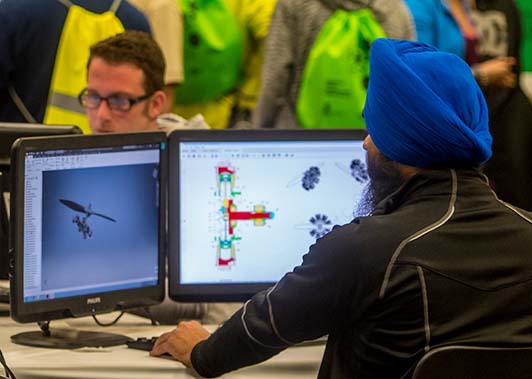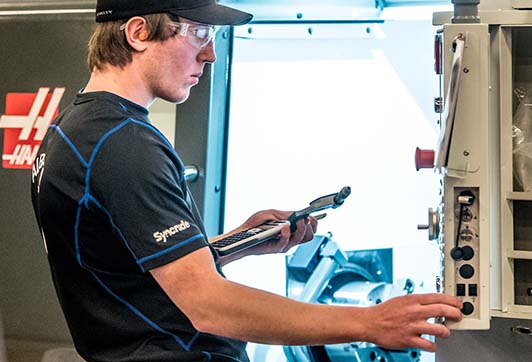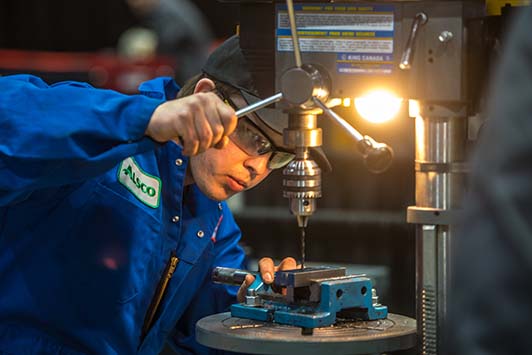Mechatronics
What is mechatronics?
Mechatronics combines the technologies of mechanics, pneumatics, hydraulics, electronics, information processing, basic electricity, and motor and motion control. A career in this field can involve assembly, manufacture, maintenance and commissioning of automation machinery, products and production systems. Workers are required to complete the mechanical, electrical and pneumatic assembly of a parts transfer system in accordance with provided documentation and schematics. The electrical wiring involved in this work includes input and output connections, sensor and motor wiring, switches, push buttons, and pneumatic solenoids.
Mechatronics workers must have a broad knowledge base, including a familiarity with pneumatic, hydraulic and electrical symbology, relay logic and ladder diagram wiring and programming techniques. Using tools such as multimeters, wrenches, allen keys and screwdrivers, they set up a machine so that a workpiece will be moved in accordance to a set pattern under the control of a Programmable Logic Controller (PLC). A large portion of their time is spent faultfinding, troubleshooting, and looking for hardware problems, as well as searching for ways to improve different aspects of the control project, possibly including efficiency or safety issues.
Electrical and electronics engineers perform some or all of the following duties:
- Conduct research into the feasibility, design, operation and performance of mechanical, electrical, telecommunications, control and computer engineering.
- Prepare material cost and timing estimates, reports and design specifications for a variety of different engineering disciplines.
- Design electrical and electronic circuits, components, systems and equipment, plants, machines, components, tools and fixtures.
- Supervise and inspect the installation, modification, testing and operation of mechanical, telecommunication, computer, control and electronic in an industrial facility.
- Develop maintenance and operating standards for all engineering systems within a building or organization.
- Investigate failures of mechanical, electrical, computer, control or telecommunication products.
- Prepare contract documents and evaluate tenders for construction or maintenance
- May supervise technicians, technologists, programmers, and analysts
HOW TO JOIN THE FIELD
A two- or three-year college Engineering Technology diploma in Mechatronics/Robotics
A bachelor’s degree in electrical or electronics engineering or in an appropriate related engineering discipline
Licensing by a provincial or territorial association of is required to approve engineering drawings and reports and to practise as a Certified Engineering Technologist (CET) or a Professional Technologist (Ptech)
Engineering Technologists are eligible for registration following graduation from an accredited educational program, and after three or four years of supervised work experience in engineering technology and passing a professional practice examination.
Supervisory and senior positions in this unit group require experience.
INDIGENOUS AND REMOTE CONSIDERATIONS
Many Indigenous and remote communities do not have the same access to information and experience when it comes to science, mathematics and technology fields. This would likely mean that students from these communities may need extra support when they are pursuing this field both in post-secondary school, as well as on-the-job.
Indigenous and remote communities are catching up to southern Canada when it comes to digital technology and computer skills and industries. Not all communities have access to reliable, affordable internet and service interruptions are all too common. Access to computers at home is not a given for everyone and Elders and even sometimes younger generations lack computer knowledge, although this situation is undergoing some significant changes at the moment. But even those people in Indigenous and remote communities with interest and high-level skills in computers may not have the same access to opportunities to learn about different programs and may face significant bandwidth issues, limiting their ability to learn and develop in this field. Indigenous and remote students may need qualifying courses or need to augment college learning to be successful in this field.
Although with significant improvements currently underway to internet connections in Indigenous and remote communities, careers in this field become more viable and are likely to become more so in years to come.
DISABILITY CONSIDERATIONS
As this field involves both complex thinking and analysis as well as physical operation, people with physical, intellectual and learning disabilities may need accommodations in order to be successful.
Find the right career path for you with our interactive map!
Trouvez le cheminement de carrière qui vous convient grâce à notre carte interactive!
Sample Job Titles
- Manufacturing technician
- Robotics Technologist
- Computer programmer
- Mechanical maintenance engineer
- Control systems engineer
- Electrical engineering technologist
Companies and Sectors
- Manufacturing
- Design organizations

Mechatronics and the Skills for Success Program
The key Skills for Success for this career path are:
- Numeracy
- Digital
- Reading




